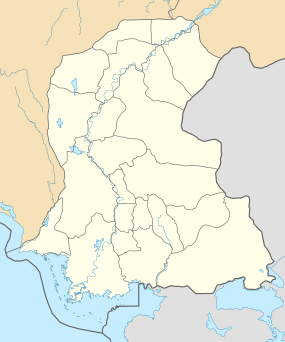Jamshoro
| Jamshoro | |
|---|---|
| City | |
 Jamshoro | |
| Coordinates: 25°16′N 68°12′E / 25.26°N 68.20°ECoordinates: 25°16′N 68°12′E / 25.26°N 68.20°E | |
| Country | Pakistan |
| Province | Sindh |
| Population (2013)[1][2] | |
| • Total | 80,000 approx |
| Time zone | PST (UTC+5) |
| Number of towns | 1 |
| Website |
www |
Jamshoro (Sindhi: ڄام شورو), (Urdu: جامشورو), is a city and capital of Jamshoro District, Sindh, Pakistan. Jamshoro, the site of largest University residential campus in the country, situated about 18 kilometers from Hyderabad on the right bank of River Indus, was a rather desolate hilly track until 1955 when it was selected for the establishment of Sindh University Campus. The site was selected to be a University township away from the humdrum of Hyderabad city which lacked room to meet the ambitious expansion programs of the University.
Interestingly, Jamshoro is virtually the gate-way to the Indus Valley, now world famous for its civilization and rich cultural heritage. The Ranikot Fort is located 40 km. to the north of the campus, in the northward continuation of the same hilly track which become Laki Ranges, merging with the Khirthars northwards. Amri, an important archeological site, lies about 15 km. further north. Sehwan, a well known township lies 25 km. to the north of Amri. Mancher Lake the largest fresh water lake in the region, is situated to the west north west of Sehwan. Travelling about 150 km. north through the Indus plains brings one to the site of Moen-jo-Daro, the most important archeological discovery of the Valley.
The development programs initiated in 1959 have gradually though slowly borne fruit. Though still in progress, over the years about 20 teaching blocks, housing 39 institutes departments and centers have been constructed. Five halls of students residence provide accommodation for about 1800 students. A beautiful pavilion-the Hyder Bux Jatoi Pavilion has been constructed to provide indoor games facility, track for athletics and sports grounds. Fatima Jinnah Gymnasium provides games and sports facility exclusively for girls. The Institute of Sindhology building, depicting the cultural heritage of Sindh, adores the entrance to the campus from the Highway. The imposing central library building, named after Late Allama I. I.Kazi, the first Vice-chancellor of the University at Hyderabad, who conceptualized this campus, serves as a land mark even from a distance.The campus itself has been named as Allama I.I. Kazi Campus as a tribute to the great scholar and visionary.
History
Ranikot Fort is a historical fort near Sann, Jamshoro District, Sindh, Pakistan.[3] Ranikot Fort is also known as The Great Wall of Sindh and is believed to be the world's largest fort with a circumference of approximately 26 kilometres (16 mi).[4] Since 1993, it has been on the tentative list of UNESCO World Heritage Sites.[5]
Archaeologists point to 17th century as its time of first construction but now Sindh archaeologists agree that some of the present structure was reconstructed by Mir Karam Ali Khan Talpur Baloch and his brother Mir Murad Ali Baloch in 1812 at a cost of 1.2 million rupees (Sindh Gazetteer, 677).[6]
Universities
- University of Sindh
- Mehran University of Engineering and Technology
- Liaquat University of Medical and Health Sciences
Schools and colleges
- Cadet College Petaro
- Pak Turk International School & College Jamshoro
- The City School Jamshoro campus
- The Educators Branch Jamshoro
- Mehran University Public School and College Jamshoro
- Army Public School Petaro
Location
Jamshoro, is situated on the right bank of Indus River at south-west position of Province of Sindh sloping from direction North-east to south-west and is about 18 kilometers far from Hyderabad and at a distance of 150 kilometers from Karachi.
Demographics
The population of Jamshoro District increased from 582,094 in 1998 to 1,176,969 in 2011, an increase of 102.2%.[8] Roughly, 95% of the Population of the city consists of immigrants from various parts of interior Sindh who migrated to the town in around 1948-2001 & to a lesser extent from 2002-2014 decades. Therefore, the city holds a number of diverse Sindhi clans & ethinic groups mainly from Jamshoro District, Dadu District, Sukkur District, Larkana District, Khairpur District, Umarkot District, Matiari District, Nawabshah District, Shikarpur District, Tharparker, Naushahro Feroze District, Badin District & Jacobabad District.[9][10][11][12] The city is predominantly Sindhi with a substantial community of Pathans, Baloch people & Seraikis. Small communities of Brahuis, Punjabis, & to a lesser extent Muhajir people are also present.[13][14][15]
Jamshoro is predominantly Muslim with a small Hindu minority.[16]
See also
References
- ↑ "Sindh population surges by 81.5 pc, households by 83.9 pc". Thenews.com.pk. 2 April 2012. Retrieved 21 April 2013.
- ↑ http://www.joshuaproject.net/peopctry.php?rop3=109027&rog3=AF
- ↑ Ranikot Fort Tourism Pakistan Retrieved 14 June 2014
- ↑ Ondaatje, Christopher (May 1996). Sindh revisited: a journey in the footsteps of Captain Sir Richard Burton : 1842-1849, the India years. HarperCollins Publishers. p. 265. ISBN 978-0-00-255436-7.
- ↑ "Ranikot Fort". UNESCO. Retrieved 20 November 2013.
- ↑ "Ranikot Fort – the Great Wall of Sindh". Islamic Arts and Culture. Retrieved 20 November 2013.
- ↑ http://www.jamshoro.gos.pk/
- ↑ Sindh population surges by 81.5 pc, households by 83.9 pc
- ↑ https://books.google.com.pk/books?id=gO6pPmYjF5MC&printsec=frontcover&dq=Sindh&hl=en&sa=X&ei=kLDWU5rbNcSGywO5g4GYBg&ved=0CB0Q6AEwAQ#v=onepage&q=Sindh&f=false
- ↑ http://www.sscnet.ucla.edu/soc/faculty/waldinger/pdf/Immigran_A23.pdf
- ↑ http://www.un.org/en/events/indigenousday/pdf/factsheet_migration_final.pdf
- ↑ http://www.iza.org/conference_files/AMM_2013/zhang_d5367.pdf
- ↑ http://www.jamshoro.com.pk/
- 1 2 http://www.nips.org.pk/abstract_files/Priliminary%20Report%20Final.pdf
- ↑ http://siteresources.worldbank.org/PAKISTANEXTN/Resources/293051-1241610364594/6097548-1257441952102/balochistaneconomicreportvol2.pdf
- ↑ http://countrystudies.us/pakistan/38.htm
- ↑ http://dhsprogram.com/pubs/pdf/FR290/FR290.pdf
- ↑ http://www.census.gov.pk/index.php
http://usindh.edu.pk/about/introduction-to-jamshoro/
